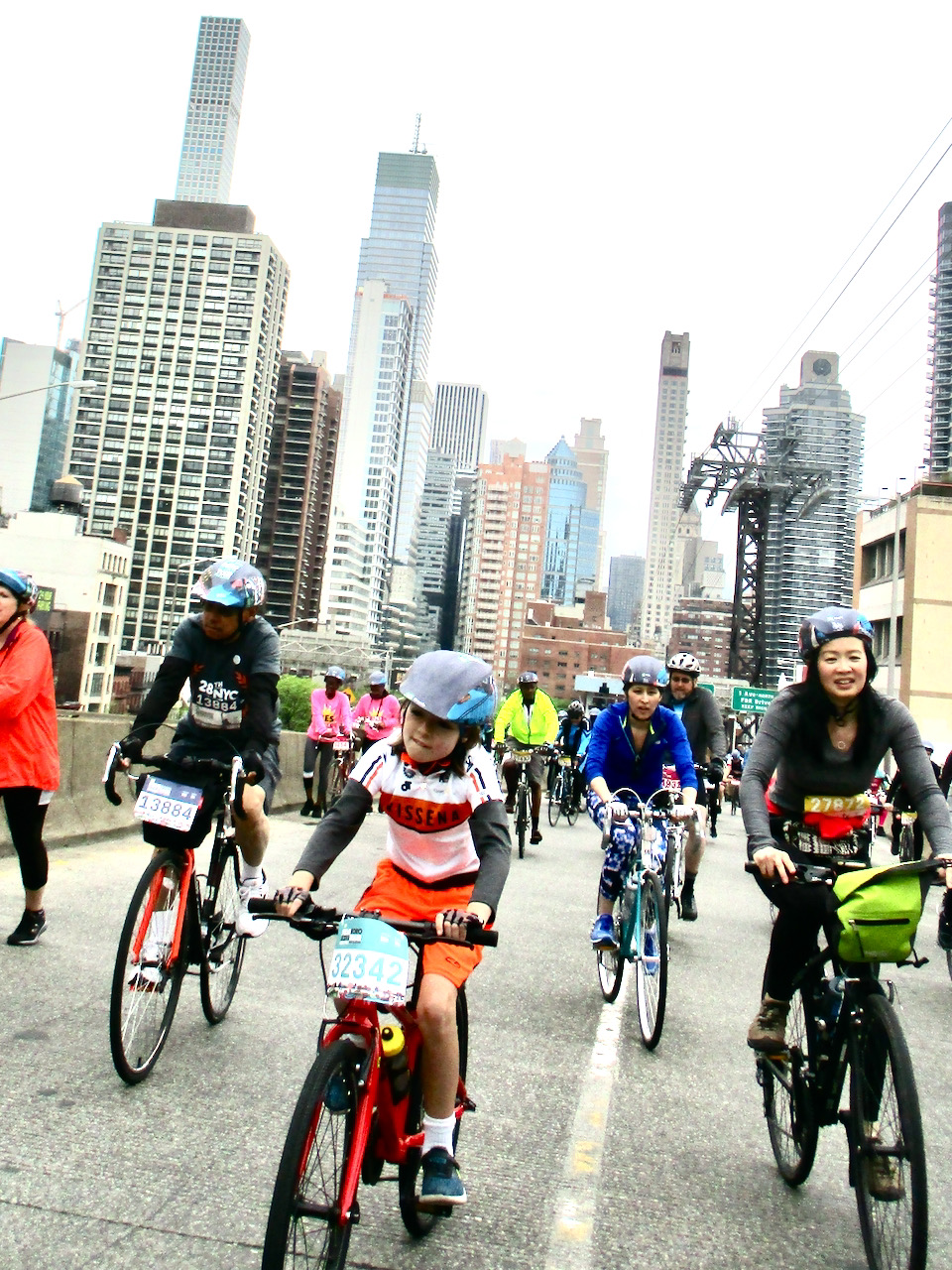Riding bikes with kids in New York City might seem impossible. Well, not impossible exactly, but dangerous.
It’s neither impossible, nor does it have to be dangerous. Have you been to Florida? I kid. Not entirely. Danger is partially a function of the speed at which cars travel, and the speed is partially a function of road design. New York City, with its 25mph speed limit and the chaos that over 8,000,000 people in the naked city engender often means drivers have to not only be driving slowly, but paying attention. And both of those things help make NYC a relatively safe place to be a cyclist.
In some places, New York City is quite suburban. Small, quiet streets with single-family homes. Lots of neighborhoods have this. Some of our rides are in such places. But these aren’t the places you’re probably thinking of. It’s probably the hyper-urban environment of Midtown.
Even Midtown is entirely rideable with small kids.By that, I mean both doable and safe.
The Big Picture of Riding with Kids in New York City
Riding with children can be great fun. And the more you do it, the easier it gets, as kids skills and strength can improve quickly. Ride to school. Ride to the grocery store. Ride to ride. Thanks to streetlights everywhere and bright, easily-mounted bike lights, you don’t have to worry much about riding in the dark.
Problem is that in the more urban areas of the city, riding with them on roads that are shared with cars can be harrowing for the adults and potentially dangerous for the kids. Riding in parks also presents difficulties, because even if you have a park down the street, chances are it doesn’t have a road that’s easy to navigate or path that’s permissible for adults to ride on. And as many New Yorkers don’t have cars, schlepping both an adult bike and a kid bike somewhere can be tough.
And it should always be fun, even if it’s tough and scary at times.
Start with the law
Riding bikes on sidewalks in New York City is only permissible when two criteria are met. The first is that the wheels must be less than 26 inches in diameter. The second is that the rider of the bicycle is 12 years of age or younger. Kids under 14 are also required to wear a helmet. Not that I’ve ever heard of a kid or adult getting ticketed in NYC.
Complete NYC Bike Rules and Regulations can be found here. New York State Bike Laws can be found here. They’ve got directives for bike riding with juniors in NYC.
There is already lots of advice avalable online on how to teach kids to ride. I’m partial to starting with pedals off and kids using the bike as a Draisene, aka push bike, aka like-a-bike. My big warning to adults is never to grab an arm or handlebar. If you’re going to handle a tyke while they’re learning to ride, the only spot on the bike you should grab is the back of the saddle.
Now that you know the law and how to teach kids riding in NYC
My recommendation is that if you want to get your kids to ride more, first take them to a quiet park or empty basketball court or flat, grassy field where you can help them learn to balance on their own and observe them practicing until they get the hang of it, becoming comfortable even. If no one else is around, you can probably ride alongside them. Knowing how to start, stop, turn, ride a straight line, and signal are all essential skills. Gameify the learning if you can.
Kids are and aren’t small adults. They aren’t as good at depth perception, so they can’t easily discern the speed of a car, or the speed they’re going, as well as an adult can. This means you need to be aware that they’re likely less aware of oncoming cars or cars coming down cross streets. Positively, if they’re motivated, they’re likely better than adults at brushing off a crash.
When they’re ready,
Try taking them to rides that are comprised entirely of off-street bike paths or just do the car-free segments of rides, like the Vanderbilt Motor Parkway in Queens, or Fort Wadsworth in Staten Island, or the bike path in Van Cortlandt Park (maybe not midday on summer weekends). Central Park, Prospect Park, the Marine Park Oval are obvious car-free selections, but any waterfront bike path can be great as well, and there are those in every borough. There are waterfront bike paths in New Jersey as well, and both Liberty State Park and Lincoln Park are also easy for kids.
Fitness Required
I’ve been told that for kids under 10 years of age, riding up to 10 miles at a stretch is easily doable with a little training. Whether or not its easy is probably up to how motivated the youngster feels; I’ve known 10 year-olds who have ridden The Five Boro Bike Tour, 45 miles, on very little training. All the same, probably shooting for five miles or fewer is more easily attainable. And, at the start, just getting them riding any distance at all is plenty. If possible, start with a place they’ve already been to and/or walked around, like around the block first. When the grommet gains confidence and fitness, start to make the rides longer, and with purpose. Like riding to the nearest park to enjoy the playground, then to the end of that park, to to school, and so on.
Strategizing Riding With Kids in NYC
If you’re planning a ride with a kid, particularly when the juvie is new to individual two-wheel pedaling, it might be a good idea to do the proposed route yourself first, so you can better prepare for how to ride it. A good riding tip for streets that feel ‘dangerous’ was that the small fry rides on the sidewalk while the parent rides parallel to them in the street. The parent accompanies them across the intersection. Then, if the road seems quiet, the kid rides on the street until the road seems to be getting busy with car traffic, then back on the sidewalk. This can be a way to deal with busy streets. If the street seems too crowded, too torn up, too busy, too fast, too narrow, any, some, or all of these, send your kid to the sidewalk. then ride alongside on the street.
The first challenge in riding parallel is them getting used to you not being alongside them. The next is getting them to use a bell or to speak up when approaching people. Obviously, your kid crashing into people is not something you want to happen, but when they’re young they’re not going fast, so the danger is pretty small.
Lead From Behind
A technique that is potentially both good for the kid and the adult riding with them is for the kid to ride first and the adult to follow. As the adult is much bigger than the kid, oncoming car traffic will have an easier time seeing the adult. And as the adult is bigger than the kid, the adult can literally look over the kid to advise them in real time to: move a bit to the left, to the right, stay in the bike lane, but not so close to the parked cars, watch out for the pothole, the puddle, etc. Leading from behind also means the adult is less likely to ride away from the kid.
Most importantly, the adult can see ahead to obstructions, like stopped cars, and then quickly look back to see if any cars are approaching from behind. If no car is close enough, the adult can tell the kid it’s safe to move further out into the street and follow the kid so that the kid has protection.
Different Kinds of Bike Paths
For better or worse, New York City is always a work in progress. Some things are great, some so stupid it boggles the mind. Some places, riding will feel safe and easy, in others, you’ll feel that a safety feature the city put down is designed to kill you. You always have the right of refusal with these things; always put your safety first. And when you’re riding with kids in NYC, put both your safety and theirs first. Let people yell at you. Thank them, politely, then ignore them.
No path at all
The law generally directs you to ride as far to the side of a street as you deem safe. On two-way streets, that means riding as far to the right as you believe is proper. The law gives you have discretion. You don’t want to get run over, but you also don’t want to crash because you’re riding where there’s lots of detritus and potholes, and you don’t want to get doored. In practice, this means riding far enough away from parked cars as not to get doored, and far enough away from the side not to have to swerve around leaf piles, broken bottles, assorted junk. On one-way streets, you probably want to either choose the left side, both because drivers drive on the left which means they’ll be able to see you more easily and because it’s less likely that you’ll get doored, or choose the right side if there are no cars parked along the right curb
Sharrows
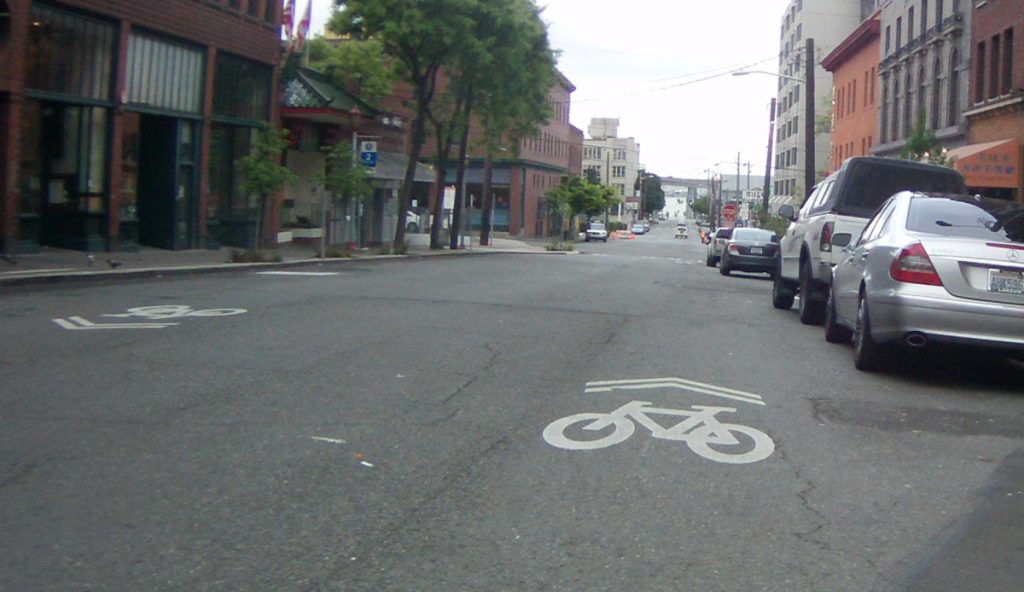
Sharrows, or short arrows, are that. Two arrow-shaped lines painted on the pavement, often just ahead of a bicycle image painted on the ground. There’s a debate about whether or not they work. Sharrows are found on what are termed “shared lanes.” Their purpose seems to be to remind drivers that cyclists may be on the particular road. In some cases, it’s because a municipality wants cyclists to ride on the particular road.
On Street Stripes
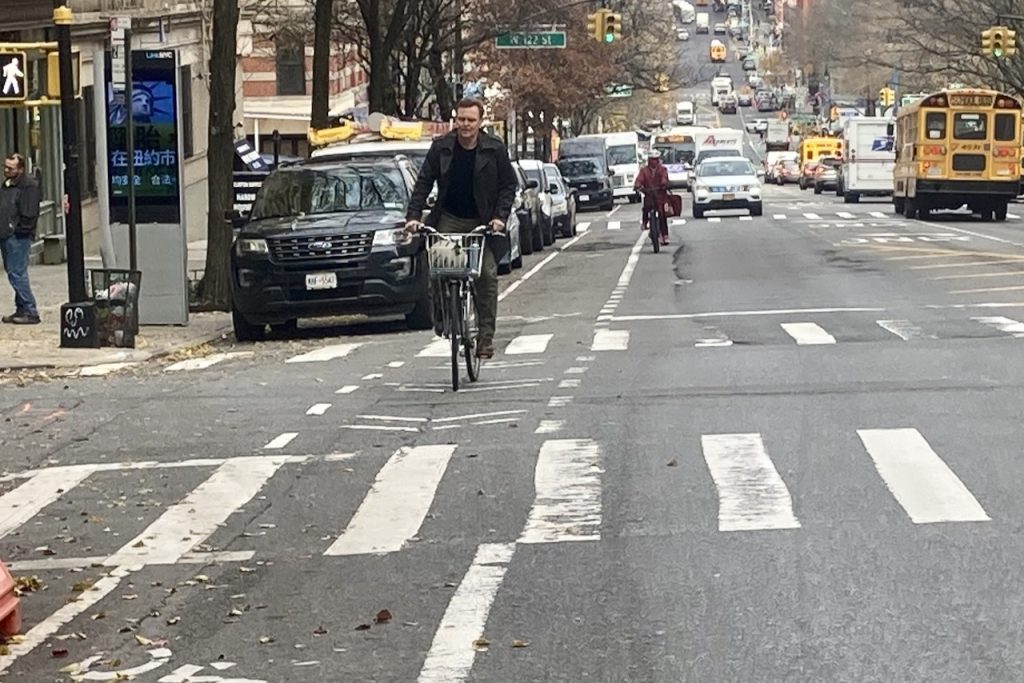
This is when you see two white painted lines a bit wider than a cyclist. They are often next to a lane of parked cars. In some cases, this shared bike lane will extend to seemingly preferential left turn spot between a crosswalk and where cars stop at a light. Generally, I suggest sticking to the outer half of the striped lane, closer to moving traffic and farther from the dooring zone alongside the parked cars.
Protected On Street Paths
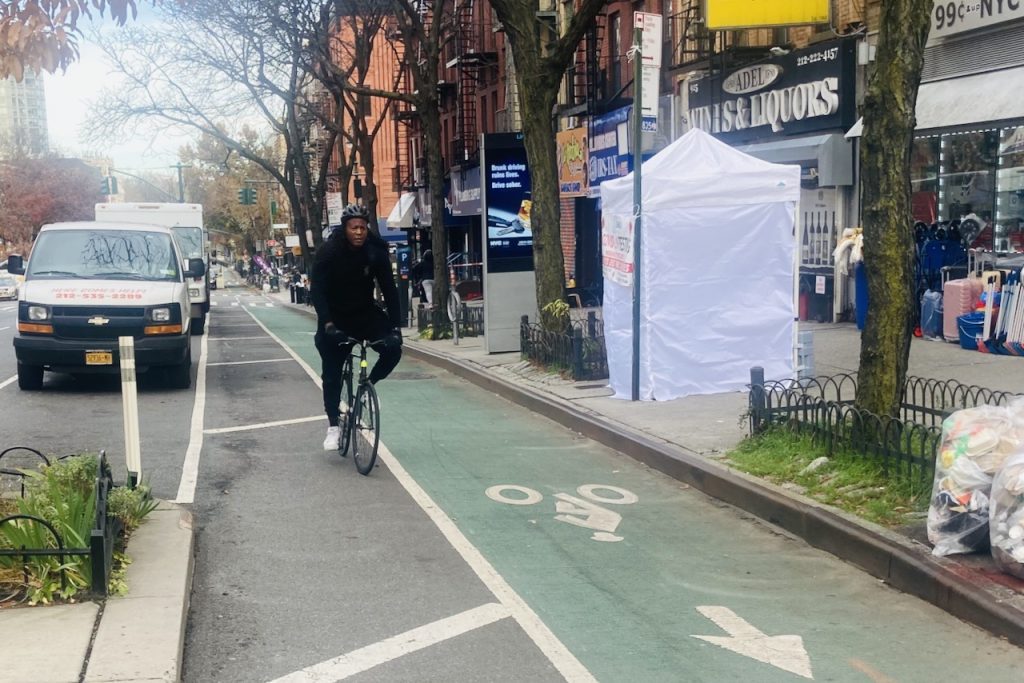
These are sometimes painted green and are often between a raised curb and a striped buffer zone. My suggestion is to stay closer to the striped buffer zone, provided a restaurant hasn’t built out onto the buffer zone. Pedestrians seem more likely to walk off the curb into the bike lane than they seem to get out of parked cars. Also by sticking to a side of the lane, you’re making it easier for faster cyclists to pass. The more dangerous spot is when the protected lane is broken up by a turning lane for cars.
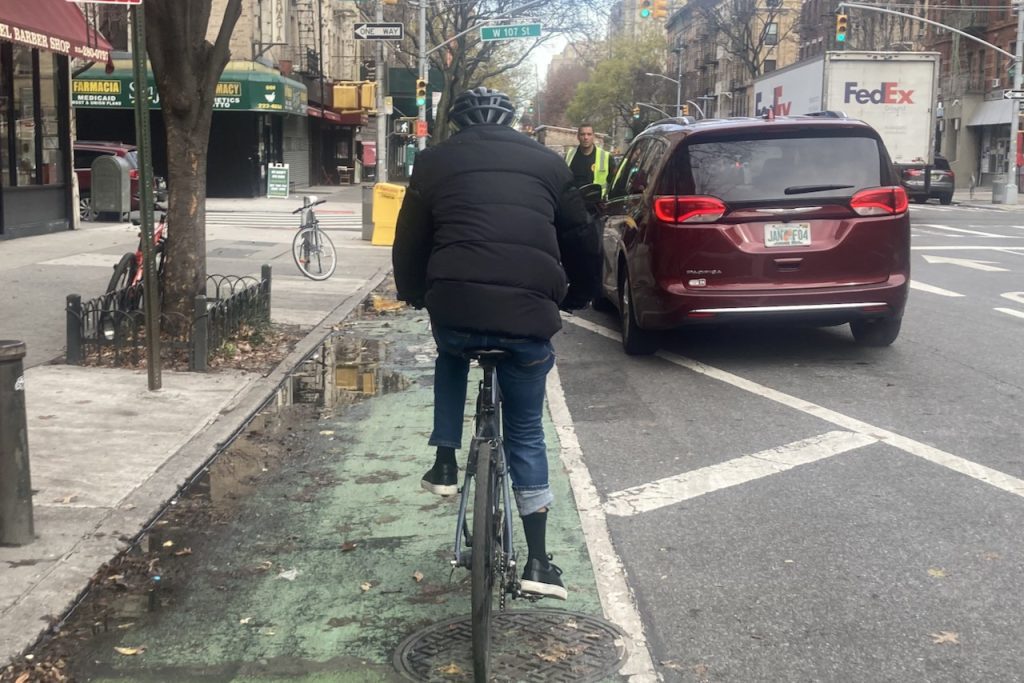
Off Street Paths
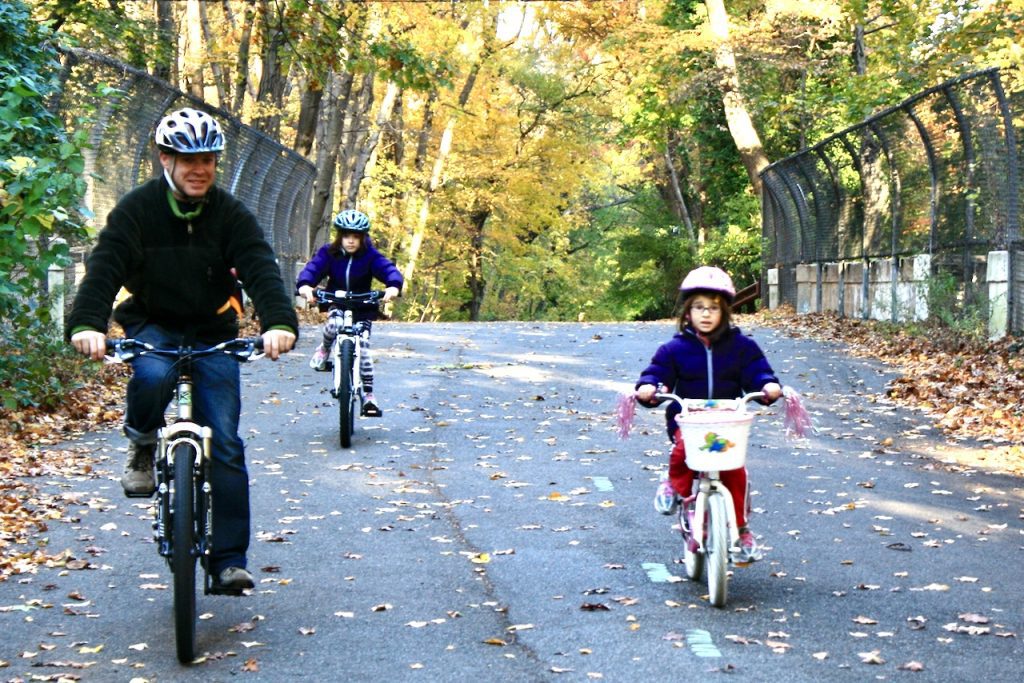
The forever problem for cyclists in New York City is that after they help make an area safe to ride, like Central Park at night, or organize to get the city to provide a dedicated bike path, like the dedicated bike path on the westbound lanes of The Brooklyn Bridge, pedestrians and joggers and runners decide they should use it, too. While riding, you’re not going to win any arguments. So, be aware. Best just to say something polite, even if you mean it sarcastically, as you ride away.
For More Information
Both New York City and New York State have webpages with good riding advice. When you’re riding with kids in NYC, more info is better.
Helmets Are Free in NYC
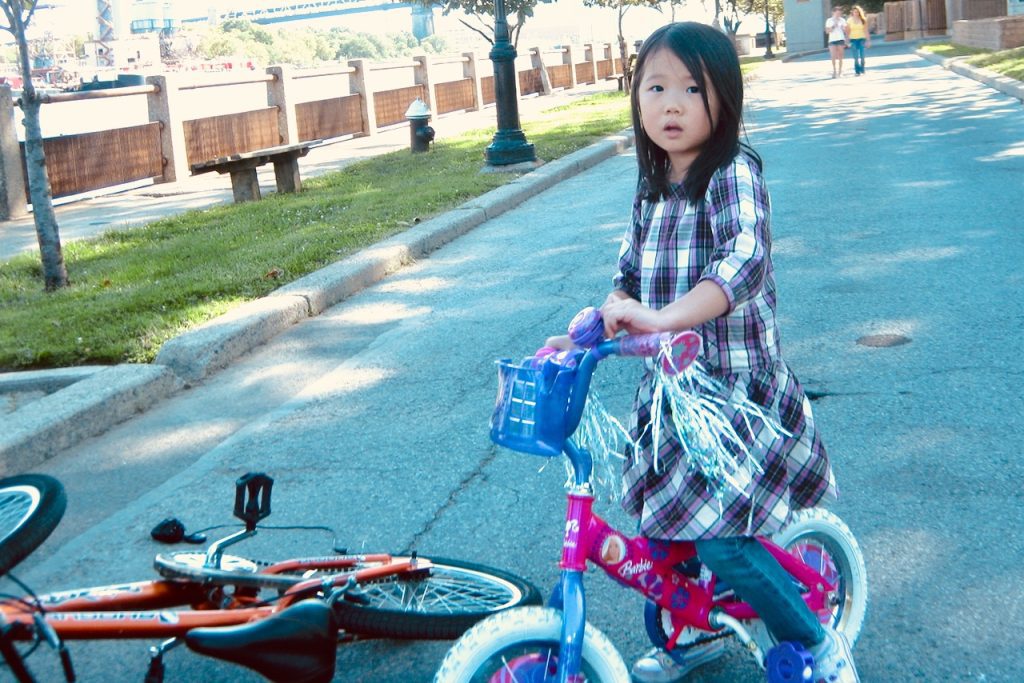
They can be.
While a bike helmet does not make a person safe, it can, when properly worn, protect a person from most potential head impacts. As a brain is the one of the things a human can’t live without, and concussions can have lasting effects, wearing a safe, properly-fitted helmet is a good habit to get yourself and your kids into. New York City gives away bike helmets on a regular basis. It’s done by schools, at events, and more.
You can find out more about helmet-fitting and helmet giveaways on the NYCDoT’s website.
